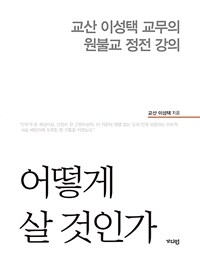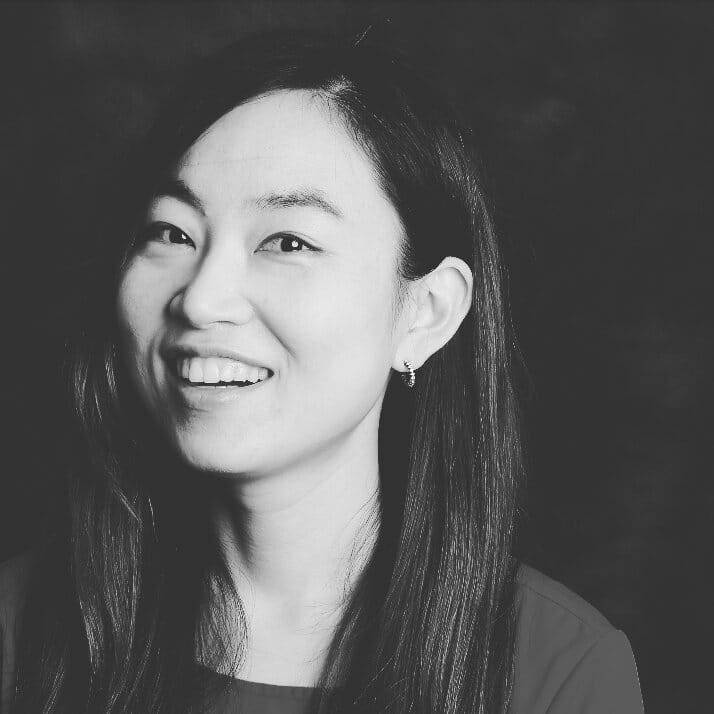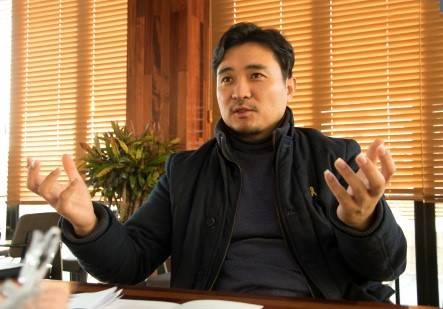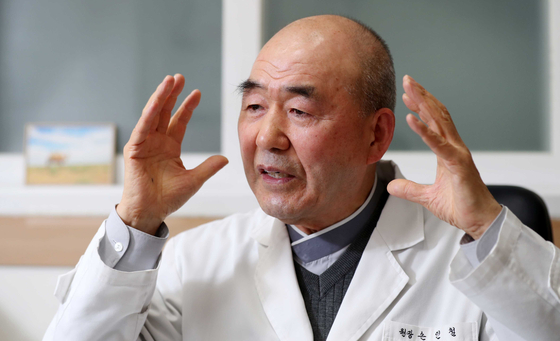어떻게 살 것인가 - 교산 이성택 교무의 원불교 정전 강의
이성택 (지은이) | 가디언 | 2019-01-21

584쪽 | 170*225mm | 1110g | ISBN : 9791189159160
국내도서 > 종교/역학 > 세계의 종교 > 원불교

교산 이성택 교무는 WBS 원음방송에서 대종사의 원불교 교리에 대한 강의를 통해 이 시대의 정신을 세우려는 노력을 아끼지 않았다. 이 강의 중에서 원불교전서의 핵심인 정전편에 대해 강의한 내용을 바탕으로 집필하였다.
원불교 교단에서 교무로 일생을 살아온 그가 몸과 마음을 어떻게 다스리고 수행했는지에 대한 방법과 가르침이 모두 담겨 있다. 이 책은 죽음 뒤의 세계나 다음 생을 위한 삶보다는 우리가 이생, 즉 현재를 살아가는 이유와 목적을 설명하고 인류가 마주할 미래를 깊은 통찰력을 통해 전망하며 그 대비책까지 제시해준다.

들어가며 어떻게 살 것인가
정전은 어떻게 만들어졌는가?
1부 정전에 대하여 - 총서편
1장 왜 마음을 학습하는가? - 개교의 동기
2장 우리는 무엇을 향하고 있는가? - 교법의 총설
2부 열린 시대의 큰 흐름 - 교의편
1장 원이 의미하는 것 - 일원상
일원상의 진리 ㅣ 일원상의 신앙 ㅣ 일원상의 수행 ㅣ 일원상 서원문 ㅣ 일원상 법어 ㅣ 게송
2장 사람에게 불공하는 법 - 사은
천지은 ㅣ 부모은 ㅣ 동포은 ㅣ 법률은
3장 네 가지 불공에 대하여 - 사요
자력 양성 ㅣ 지자 본위 ㅣ 타자녀 교육 ㅣ 공도자 숭배
4장 수행의 세 가지 공부법 - 삼학
정신 수양 ㅣ 사리 연구 ㅣ 작업 취사
5장 마음 학습의 여덟 가지 방법 - 팔조
진행 4조 ㅣ 사연 4조
6장 삶과 마음공부의 길을 밝히다 - 인생의 요도와 공부의 요도
7장 진리를 알아가는 네 가지 방법 - 사대 강령
3부 열린 시대의 실천 방법 - 수행편
1장 생활 속에서 실천하는 법 - 일상 수행의 요법
2장 어떻게 훈련해야 하는가? - 정기 훈련과 상시 훈련
정기 훈련법 ㅣ 상시 훈련법 ㅣ 정기 훈련법과 상시 훈련법의 관계
3장 천만 경계를 일념으로 모으다 - 염불법
4장 망념을 쉬게 하라 - 좌선법
5장 던져야 하는 질문의 목록 - 의두 요목
6장 훈련의 전반을 평가하기 - 일기법
7장 어느 곳, 어느 때나 참선하기 - 무시선법
8장 과거의 잘못을 돌아보기 - 참회문
9장 일원상 신앙의 실천 방법 - 심고와 기도
10장 부처께 공을 들이자 - 불공하는 법
11장 지켜야 할 서른 가지 계율 - 계문
12장 성품을 다스리는 방법 - 솔성 요론
13장 대각 후 첫 설법 - 최초 법어
14장 고통과 즐거움에서 벗어나기- 고락에 대한 법문
15장 아픈 세상은 어떻게 치유되는가? - 병든 사회와 그 치료법
16장 마음과 몸을 함께 학습하다 - 영육 쌍전 법
17장 마음 학습의 단계적 목표 - 법위 등급
나오며 이 시대의 트렌드에 대하여
------
● 서문
이 시대에 잘 산다는 것에 대하여
우리가 사는 이 시대를 4차 산업혁명 시대라고 합니다. 그리고 우리 모두 실생활에서도 감지하듯이 4차 산업혁명은 인류의 삶에 큰 변화를 가져오고 있습니다. 삶이 변할 뿐 아니라 변하는 속도도 엄청나게 빨라서 어지럼증을 느낄 정도입니다. 이제 지구상의 누구도 이 변화와 속도와 무관하게 살 수 없는 상황이 되었습니다.
저는 매일 아침마다 10여 통이 넘는 문자를 받습니다. 칼럼, 일상의 상식 등 문자 내용이 다양한데, 이제 그 문자를 읽으며 하루를 시작하는 것에 익숙합니다. 그런데 이 문자에 새로운 단어, 들어본 적 없는 용어들이 등장해서 당황할 때가 있습니다. 예를 들어 AI, 블록체인, 커넥티드 카, 사물 인터넷과 같은 단어를 문자를 통해 접하게 되는데, 그럴 때마다 이 시대가 저와는 무관하게 엄청난 속도로 변하고 있다는 걸 실감합니다.
4차 산업혁명도 이전의 산업혁명과 마찬가지로 인간의 기술이 이루어낸 물질문명입니다. 물론 과거의 산업혁명과는 비교할 수 없는 속도로 인류에게 편리를 제공하고 있습니다. 그러나 편리함의 이면에는 부정적인 측면들도 있습니다. 사람들이 습득한 지식의 유효기간이 말할 수 없이 짧아져서 그 흐름을 쫓아가느라 항상 경쟁에 시달리고 있습니다. 또 얼마 전에 겪었던 KT 기지국 화재 사고처럼 예상치 못한 어떤 일로 인해 일상생활 전체가 마비될 위험도 있습니다. 이렇게 물질문명이 발달된 시대에도 젊은이들의 실업 문제 등 생계와 관련된 기본적인 문제들이 여전히 해결되지 못한 채 남아 있습니다.
그래서 저는 이런 시대일수록 인간은 ‘어떻게 살 것인가?’라는 질문을 던져야 한다고 생각합니다. 물질문명의 발달로는 해결되지 않는 인간의 문제는 이런 질문을 거치지 않을 수 없습니다.
사실 이 질문은 아주 오랜 과거부터 다양한 형태로 제기되었습니다. 가까이에서 그 예를 찾자면, 구한말 시기에 민초들이 제기했던 이념을 들 수 있겠습니다. 국운이 기울고 세계열강이 문호 개방을 무력적으로 요구해오던 시기에 민초들은 나라의 중흥을 염원하며 이념을 만들어냈습니다. 그 이념은 조선에서만 가능했던, 문화적 토양을 반영한 사상입니다.
그 이념이 개벽 사상입니다. 열 개開, 열릴 벽闢입니다. 민중의 잠재의식 속에 깔려 있는 이런 열망을 제일 먼저 끄집어낸 분이 천도교를 창교한 수운 대신사입니다. 대신사께서는 대각 후에 백성들을 향해 ‘인내천人乃天 하니 사인여천事人如天 하라’는 메시지를 주셨습니다. 대신사의 이 말씀은 당시 사람대접을 받지 못한 수많은 대중으로부터 폭발적인 환호를 받았습니다. 수많은 사람이 경주 용담으로 모여들었고 스스로가 하늘임을 확인한 것이지요. 신분제도에 염증을 느낀 사람들에게는 엄청난 생각이 아닐 수 없습니다. 위정자들은 자신들이 기득권을 차지하고 있는 당시 체제를 뒤흔들 종교라고 보았습니다. 그래서 이념 운동을 처음 주창한 대신사께서는 위정자들에 의해서 처형당하십니다. 대각하신지 채 4년이 되지 못하여 경상 감영이 있는 대구에서 형장의 이슬로 사라지셨습니다.
대신사의 뒤를 이어 개벽의 새 역사를 주창하신 분은 증산교를 일으킨 강증산 천사입니다. 모악산 대원사에서 대각을 이루시고 스스로를 상제라고 부르며 수많은 이적을 통해 사람들을 모으셨습니다. 물론 후천개벽 새 시대를 주창하신 것이지요. 증산 천사께서는 대각을 이루시고 천지 도수를 천명하니 선천 시대는 상극 시대, 후천 시대는 상생 시대로 규정하십니다. 선천이 상극 시대라 서로 나뉘어서 싸우고 분열되었다고 보셨습니다. 서로 상극으로 얽혀서 전쟁을 하고 그 원한이 신명계에 쌓여 있다는 것입니다. 즉, 선천 시대에 싸움한 원한이 음부계에 가득히 녹아 있다는 것입니다. 음부계와 현실계는 상호작용하여 연결되어 있기 때문에 이 원한을 풀기 전에 현실계가 상생 세계가 되기는 불가능합니다. 그래서 증산 천사께서는 신명계에 어린 원한을 푸는 천지 공사를 하십니다. 이 거창한 공사를 통해서 선천 시대 모든 원한을 싹 풀어버립니다. 그러나 곧바로 후천개벽의 선경 시대가 오느냐? 아직은 아닙니다. 선천 시대의 분열은 신단의 분열이 그 근본 원인입니다. 가정마다 모시는 신, 지역마다 모시는 신, 나라마다 모시는 신, 국가마다 모시는 신, 종교마다 모시는 신이 다르기 때문에 분열과 전쟁이 일어난 것입니다. 그래서 강증산 천사께서 이런 분열된 모든 신단들을 하나의 신단으로 통일시키는 공사를 합니다. 이것이 통일 신단 공사입니다. 신단 통일은 바로 현실 세계를 하나로 만드는 밑바탕입니다. 이런 일련의 후천개벽 공사를 하던 중 대각 후 9년여 만에 갑자기 화천하게 됩니다.
후천개벽 사상을 마지막으로 주창하신 분은 1916년에 대각하신 소태산 박중빈 대종사이십니다. 대각 후 ‘만유가 한 체성이요, 만법이 한 근원이로다. 이 가운데 생멸 없는 도와 인과 보응하는 이치가 서로 바탕하여 두렷한 한 기틀을 지었도다’라는 일성을 토로하셨습니다. 이 대각 일성 속에 개벽 사상이 지향하는 이념과 사상이 함축되어 있습니다. ‘하나이니 하나로’ 이것이 바로 개벽 사상을 집대성한 말입니다. 그리고는 이 개벽 사상을 구체화하여 이론적 체계를 세우는 작업을 꾸준히 진행합니다. 사실 각覺의 내용을 문자로 나타내는 작업은 그렇게 간단한 것이 아닙니다. 앞에 나타난 두 분 선지자들은 이런 작업을 할 시간을 가질 수 없었습니다. 소태산 박중빈 대종사께서는 대각을 이루신 후 원불교라는 교단을 창립하는 과정에서 여러 해야 할 일들이 있었겠지만, 개벽 이념들을 문자로 만들고 그 방법들을 정리하는 작업이야말로 당신의 가장 중요한 과제였다는 것을 아셨음은 분명합니다. 그래서 여러 가지 과정들을 거치면서 작은 책자들을 발행하고 끊임없는 경전 결집 과정을 진행시키십니다. 교조 스스로가 깨달은 내용을 경전화한다는 것은 모든 종교를 통틀어 선례가 없는 일입니다. 교조 스스로가 집필한 경전, 그 경전이 바로 원불교의 정전正典입니다. 1943년 소태산 대종사께서 열반에 드시기 전에 집필을 완성한 내용이 정전에 고스란히 담겨 있습니다. 원불교 정전은 이처럼 후천개벽의 지침서이며, 개벽 세상의 설계도이며, 구한말 민중에 배태되어 태어난 개벽 사상의 이념서이며 결정판입니다.
어떻게 살 것인가? 이 질문은 시대를 초월하여 모든 사람의 화두라고 하였습니다. 그러나 물질 개벽이라는 현상이 물밀듯이 다가오는 현 시대에 어떤 정신을 가지고 살아야 할 것인가,라는 질문은 그 어느 때보다 중요합니다. 그리고 그 해답은 바로 원불교 정전에서 찾을 수 있습니다. 저는 이 시대적인 응답서를 방송으로 강의하였습니다. ‘물질이 개벽되니 정신을 개벽하자’라는 원불교 개교 표어를 마음에 새기면서 4차 산업혁명 뒤에 오게 될 5차 산업혁명 시대, 즉 마음 산업 시대를 꿈꾸면서 말입니다. 인간이 싸워야 할 대상은 물질만이 아닙니다. 인간은 결국 자신과도 싸워야 합니다. 정신은 자신과의 치열한 싸움에서 개벽됩니다. 정신을 개벽하여 자주력이 확고히 세워지고, 그 자주력으로 인간이 만든 천만 물질을 활용할 때 개벽의 새 세상은 우리에게 다가올 것입니다. 저는 이 책이 이런 시대적 상황에서 방황하는 사람들의 지침서가 되기를 희망합니다.

P.8
어떻게 살 것인가? 이 질문은 시대를 초월하여 모든 사람의 화두라고 하였습니다. 그러나 물질 개벽이라는 현상이 물밀듯이 다가오는 현 시대에 어떤 정신을 가지고 살아야 할 것인가,라는 질문은 그 어느 때보다 중요합니다. 그리고 그 해답은 바로 원불교 정전에서 찾을 수 있습니다.
- ‘어떻게 살 것인가’ 중에서
P.29
우리 정전은 불교에 연원을 두고 회상의 면모를 살핀 경입니다. 형성 과정에서 불교에 연원을 대서, 제일 처음 이름이 불교 정전입니다. ‘원불교는 불교 아니다’는 말은 하면 안 됩니다. 왜냐하면 대종사께서 불교에 연원을 댔고 첫 경전의 제목은 불교 정전이기 때문입니다. 원불교 정전의 정체성이 확실히 드러납니다.
- ‘정전은 어떻게 만들어졌는가?’ 중에서

P.39
과거에는 서구 사회를 물질문명으로, 동양 사회를 정신문명이라는 단어로 많이 불렀습니다. 인문학의 기본은 역사입니다. 아마 단재 신채호 선생이 ‘역사를 잊어버리는 민족과 국가는 미래가 없다’고 말한 이유일 겁니다. 그런데 지금 한국이나 세계에서는 그런 단어들이 무색해져버렸습니다.
- ‘왜 마음을 학습하는가?’ 중에서
P.63
대종사께서 총서편에서 세상의 문제, 종교의 문제, 시대의 문제, 종교 내부의 문제 등을 모두 지적하시고 어떻게 해결해야 하는지 방법까지 제시하셨습니다. 원불교 교단이 나가야 할 방향은 광대무량한 낙원 세계입니다. 교법의 총설을 보면 일원상의 진리를 주체로 한 사은과 삼학, 신앙과 수행의 강령이 주체이니 이것으로 원만한 신자가 되자는, 원불교가 나아가야 할 방향을 말하고 있습니다. 이 점을 잘 알아두면 도움이 될 것 같습니다.
- ‘우리는 무엇을 향하고 있는가?’ 중에서

더보기

지은이 : 이성택
저자파일
최고의 작품 투표
신간알리미 신청
 최근작 : <어떻게 살 것인가>,<이성택 교무의 0분의 1인생> … 총 2종 (모두보기)
최근작 : <어떻게 살 것인가>,<이성택 교무의 0분의 1인생> … 총 2종 (모두보기) 소개 :
소개 : 1943년 경북 김천에서 태어났다. 경북대학교 수의과대학에 입학했고, 1962년 3월 대구교당에서 원불교에 입교했다. 이때 항타원 이경순 종사의 자비와 훈풍에 감화, 1970년 출가하여 전무출신의 길을 걷고 있다. 이후 영산선원 간사, 중앙총부 원예주무, 중앙훈련원, 원효교당, 교학대 서원관 사감, 교화부 순교무, 교정원 교화부장 겸 교화연구소장, 국제부장, 문화부장, 부산교구장 겸 부산교당 교감, 새등이문화원장, 정수위단원, 서울교구장, 교정원장, 한국종교인지도자협회 공동대표, 노무현 대통령?이명박 대통령 통일 고문, 10.4 남북정상회담 특별수행원, 원광학원 이사장을 역임했으며, 2006년 7월 종사의 법훈을 받았다.
한때는 원불교 훈련법에 매료되어 그 이론 정립에 정성을 다하였고, 사요를 중심으로 신앙문 교리에 심취하여 그 교리적 위치를 확립하는 데 지금껏 노력해오고 있다.
퇴임 후 WBS 원음방송 '마음을 찾아가는 법문 여행'을 통해 경전 강의를 하고 있으며, 현장을 누비며 후학을 위해 활발한 활동을 하고 있다. 2019년 1월부터 서울교구 교령으로 봉직하고 있다.
저서로는 ≪강자 약자 어떻게 진화할 것인가≫, ≪교리도를 통해 본 원불교 교리 이해≫, ≪자기완성의 길잡이≫, ≪원불교 훈련의 이론과 실제≫, ≪새 시대의 종교≫, ≪0분의 1 인생≫ 등을 펴내 교단 교리와 사상 정립에 이바지하였다.


우리는 지금, 어떻게 살아야 하는가?
전 교정원장 이성택 교무가 정전 강의를 통해 삶의 방향을 제시하다!
교산 이성택 교무는 WBS 원음방송에서 대종사의 원불교 교리에 대한 강의를 통해 이 시대의 정신을 세우려는 노력을 아끼지 않았다. 이번에 출간된 신간은 이 강의 중에서 원불교전서의 핵심인 정전편에 대해 강의한 내용을 바탕으로 집필하였다. ≪어떻게 살 것인가≫는 580쪽의 방대한 분량으로 원불교 교단에서 교무로 일생을 살아온 그가 몸과 마음을 어떻게 다스리고 수행했는지에 대한 방법과 가르침이 모두 담겨 있다. 이 책은 죽음 뒤의 세계나 다음 생을 위한 삶보다는 우리가 이생, 즉 현재를 살아가는 이유와 목적을 설명하고 인류가 마주할 미래를 깊은 통찰력을 통해 전망하며 그 대비책까지 제시해준다. 원불교 교리의 내용을 바탕으로 했지만 사실 내용 전반에서는 ‘인생을 어떻게 살아가야 하느냐’에 대한 질문을 끊임없이 던지고 있다. 물질문명의 속도에 지친 우리 삶의 든든한 지침서가 되기에 충분하다.
이성택 교무가 말하는 ‘잘 산다는 것’은 복을 지으며 사는 것이고, 복을 짓는다는 것은 남에게 베푸는 것이다. 복을 지으려면 몸과 마음과 돈을 써야 하고, 그러려면 늘 마음공부를 해야 한다는 것이 그의 생각이다. 그러므로 남에게 베푸는 것은 남을 위한 일만이 아니다. 복을 지으면 결국은 그 복이 다 자신에게로 돌아오게 되어 있다. 그것이 원불교가 말하는 인과응보 법칙의 중심이며, 더불어 사는 삶의 지혜이고 원리이다.
“물질이 개벽되니 정신을 개벽하자”
마음 산업 시대를 꿈꾸다
원불교 정전에서는 바로 ‘지금’과 ‘사회’에 주목한다. 개교의 동기의 첫 단어가 ‘현하現下’로 제시된 것만 보아도 알 수 있듯, 다음 생이나 죽고 난 뒤의 세계에 대해서보다는 내가 지금 살고 있는 삶에 대한 깨달음이 우선한다. 당장의 즐거움이나 눈앞의 목표만을 추구하는 삶이 아니다. 지금 이 순간에 집중하여 몸과 마음을 닦아나가면 그만큼 복이 찾아온다는 말이다.
이 책의 한 가지 특징은 인류의 삶에 큰 변화를 가져온 4차 산업혁명 시대에서 우리가 중심을 잃지 않고 추구해나가야 할 방향성을 제시해준다는 점이다. 삶의 편의를 위해 발달한 과학 문명은 우리가 삶을 진정으로 잘 살 수 있도록 하는 것은 아니다. 오히려 더 큰 혼란과 경쟁을 불러일으키고 있다. 과학기술의 발달로는 해결할 수 없는 본질적인 문제들이 여전히, 그리고 더욱 심각한 모습으로 남아 있다. 그러므로 우리는 끊임없이 마음을 공부해야 하고 학습해야 한다. 저자는 4차 산업혁명 시대 다음에는 인간의 소중함을 바탕으로 한 마음 산업 시대가 도래할 것이라고 믿는다. 남과 치열하게 경쟁하는 삶보다 나 자신과 경쟁하는 삶이 될 것이라고 말한다.
교리는 딱딱하고 어렵기만 하다는 선입견이 무색할 만큼 꽤 ‘트렌디’한 책인 것과 동시에, ‘어떻게 살 것인가’라는 질문에 직접 답변을 해주지는 않지만 우리에게 그 답을 찾을 수 있게 도와주는 길잡이 같은 책이다.


 Hannah Kim was born in South Korea. She is an educator and restorative justice practitioner. Since 2008, Hannah has been working as a public school teacher in South Korea. After taking RJ courses in KOPI (Korean Peacebuilding Institute) in 2012, she started to apply RJ values to create a restorative classroom culture. Especially, she is dedicated to creating an anti-bullying culture in the classroom. This May, Hannah earned her M.A. in Conflict Transformation with minors in Education from EMU. Her interested area is integrating trauma healing and restorative justice with intersectional lenses for peacebuilding in education. She currently lives in Seoul and came back to teach English in a public high school in Incheon. She is planning to facilitate STAR for Educators to empower educators in South Korea next year.
Hannah Kim was born in South Korea. She is an educator and restorative justice practitioner. Since 2008, Hannah has been working as a public school teacher in South Korea. After taking RJ courses in KOPI (Korean Peacebuilding Institute) in 2012, she started to apply RJ values to create a restorative classroom culture. Especially, she is dedicated to creating an anti-bullying culture in the classroom. This May, Hannah earned her M.A. in Conflict Transformation with minors in Education from EMU. Her interested area is integrating trauma healing and restorative justice with intersectional lenses for peacebuilding in education. She currently lives in Seoul and came back to teach English in a public high school in Incheon. She is planning to facilitate STAR for Educators to empower educators in South Korea next year. Jae Young Lee graduated from Eastern Mennonite University with an MA in Conflict Transformation focusing on Restorative Justice. He began his career as a peacebuilder at Korea Anabaptist Center where he was a peace program coordinator for 10 years (2001-2010). Then he founded the Northeast Asia Regional Peacebuilding Institute (2010) where he currently serves an executive director. He also founded the Korea Peacebuilding Institute (2012), a leading organization for the Restorative Justice movement in South Korea. He has conducted various workshops and lectures on restorative justice, mediation and peacebuilding for schools, legal system, government, NGOs, and community organizations in Korea. In addition, he has facilitated at the Mindanao Peacebuilding Institute (MPI) in the Philippines and Christian Forum for Reconciliation in Northeast Asia. Currently he lives with family and staff together as a small community called the Peace Building Community near Seoul.
Jae Young Lee graduated from Eastern Mennonite University with an MA in Conflict Transformation focusing on Restorative Justice. He began his career as a peacebuilder at Korea Anabaptist Center where he was a peace program coordinator for 10 years (2001-2010). Then he founded the Northeast Asia Regional Peacebuilding Institute (2010) where he currently serves an executive director. He also founded the Korea Peacebuilding Institute (2012), a leading organization for the Restorative Justice movement in South Korea. He has conducted various workshops and lectures on restorative justice, mediation and peacebuilding for schools, legal system, government, NGOs, and community organizations in Korea. In addition, he has facilitated at the Mindanao Peacebuilding Institute (MPI) in the Philippines and Christian Forum for Reconciliation in Northeast Asia. Currently he lives with family and staff together as a small community called the Peace Building Community near Seoul.

